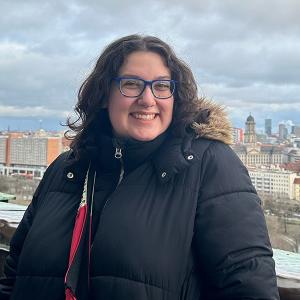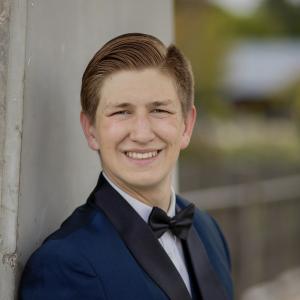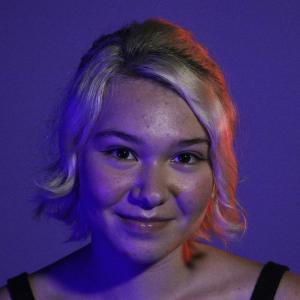Oberlin Blogs
Chordophone Quest: There and Back Again
February 5, 2015
McKinley Glasser ’18
For your listening pleasure, here is a fabulous recording of the Persian vocal master Mohammad-Reza Shajarian accompanied by piano and ney (Persian flute).
Oh, Oberlin. Snowberlin, rather, from the way things are looking right now. Everything's white and sparkly and lovely. It's also painfully cold, but at least the singular aesthetic pleasure of walking around a winter wonderland makes up for it.
I returned from the more wintery and less wonderland-y Cleveland a couple days ago, where I was working at home on my Winter Term Quest (see this post!) which involved practicing cello and learning about Persian music firsthand with an instrument called the kamancheh.
"The kolache? You're learning the radish? You're so out of tune!"
My family had doubts about my fiddling around with a Persian spike-fiddle when I had a perfectly good cello, but I finally explained to them that no, I'm not spending a month with delectable Czech pastries (widely-known in Texas, where I'm from), but with an instrument that dates back about 2000 years. Also, it's not the radish I'm learning, but the radif, a sort of collection of modes, melodies, and musical traditions unique to Persian classical music. Not least, I had to stave off frequent threats of death and destruction from my viola-playing brother, whose ears are so finely-tuned to Western intervals that my quarter tones offended his delicate intonational sensibilities (evil laughter).
It was an action-packed quest, to be sure. I won't detail the theory or the particulars of Persian music just yet, but I'm perfectly willing to be flagged down and quizzed about Persian music at any time. As long as you have a free hour or two.
When I said I wanted to study Persian music, I had no idea I was about to stumble into one of the oldest and most sophisticated musical traditions in the world. I also had no idea it was one of the least-researched; Western scholarship in this area is relatively young, dating back to about the mid 20th century. Internet searches came up largely with generalizations or webpages in Persian. Leads on teachers in the Midwest area fell short. Intrigued, I got my hands on as many books as I could.
What I discovered from these resources and from my kamancheh teacher was far more than a satisfaction of intellectual curiosity; a genuine love and appreciation for Persian/Iranian culture grew from my initial focus on its music. Music was related to poetry, and poetry to art, and before I knew it, I was learning bits of the language, too. In a way, I went on a very limited, largely naive trip through Persian culture. Since I saw The Hobbit over this break (I'm not passing judgment on that film here, but I have strong feelings), I can't help but feel like Bilbo Baggins, that bumbling little hobbit who went out on an adventure and came back changed. Sort of. There were no orcs for me to fight (except for maybe my perfect-pitch-afflicted brother), but plenty of things to see and hear, and I think my view as a whole has grown richer for it.
The end of Winter Term doesn't mean the end of my adventures with Persian music and the kamancheh. I'll certainly continue carrying around my chordophones and maybe perhaps bumping into people (the Con hallways are small and two instruments make me large, and I'm sorry). In fact, this month has shaped the coming semester in a very tangible way: as soon as I could, I dropped the computer science class I was initially excited to take and replaced it with an introduction to ethnomusicology. It's also shaped my playing of both the cello and its Persian ancestor.
The experience of learning a new instrument made me more attentive to my own. Though the kamancheh didn't directly inform my practice of concerti or friendly little major scales, and is in many respects the physical opposite of cello playing, the experience of coming from something different made my hands more receptive to my mind. I was amused to discover a kamancheh side-effect on my cello: out of nowhere, my trills became rather excessively quick and fluttery, like the ornaments in Persian music.
My ears have opened up, too, and not just from quarter tones. When I started, I was a pretty terrible imitative player. Whenever music teachers would play the call-and-response game, I always ended up playing back to them something of my own that I thought sounded convincing (it wasn't). The traditional way of learning Persian music - and many types of music, all over the world - is to repeat your teacher's phrases back to them. My teacher informed me that after a couple years of study, most students were able to repeat back 99% of what they heard with 99% accuracy. Well, after a month I'm not anywhere near that good, but there's definitely been an improvement. As my ears have wandered back home to good old simple major and minor scales, I'm aware of what they picked up on the way. And they had a darn good time going there and back again.
So that's the beauty of Winter Term, I think. It's "you time," but an extremely productive "you time" that lets you focus on your passions or explore new ones. To be cliche, it's a journey, or a breath of fresh air, or a glimpse of real life without classes or homework hovering on the periphery. It's a singular experience, but it's also what you make of it. I was lucky enough to have the resources to pursue a subject I've grown quite passionate about.
So now, here is an exclusive, shiny, EXTRA-SPECIAL brief [bad quality] performance brought to you by my iPhone and the Conservatory practice rooms in all their glory:
About my music: I'm going to attempt to explain what's going on here. What I performed were the gushes of daramad and kereshmeh in Dastgah Mahur from the radif of Mirza Abdollah. There are lots of classifications here, so I'll start with the radif. That's the overarching system for Persian classical music pedagogy and functions as a springboard for improvisation. It is also a great many other things, and very imprecise (each teacher has their own version, and Mr. Abdollah's is the most widely-accepted, pedagogically), so let's not get into that here. In the radif are seven dastgahs and five avazes, which can loosely be compared to modes in Western music. Though they are labelled differently, they essentially have the same function (avaz, confusingly, also means "song"). They each have their own character, traditions, and, if forced into Western tradition, scales. Mahur, what I'm playing, is closest to our Major scale. In these dastgahs are gushes, which can be considered mini-modes. They've been collected and added to the radif for centuries, incorporated from folk songs or composed by masters. Collectively, there are 200-300. The first one I play, daramad, means "introduction," and each dastgah and avaz has one - it introduces the general feeling and motifs. Second is the kereshmeh, which, I think, translates to "flirtation." By the end of my study, I could play 10 of these - pishdaramad, daramad, kereshmeh, feyli, shekasteh, delkesh, moqddameh dad, dad, and a tasnif (a ballad). I can't imagine trying to memorize all 300 or so!
About the professional music: Mr. Shajarian is an ostad, the Persian word for master or teacher, and his voice is considered a national treasure. He teaches at Tehran University, studies classical Persian music, and has made numerous recordings. He is also a critic of the current state of his country, and protested the 2009 Iranian presidential election results. Quoth Wikipedia: "When Iran's president, Mahmoud Ahmadinejad referred to the protesters as 'dust and trash,' Shajarian told a BBC Persian channel telephone interviewer that he (Shajarian) considered himself the voice of dust and trash: 'It is the voice of dust and trash and it will always remain the voice of dust and trash.'"
In this recording, Mr. Shajarian sings in Dastgah Mahur. Especially evident is the vocal technique of tahrir - you'll know it when you hear it.
Tags:
Similar Blog Entries
An Ode to Studying Abroad
December 5, 2024
I knew one of my main goals coming to Oberlin would be studying abroad. Little did I imagine that my dream would come true five months into my freshman year!

Mi Viaje Maravilloso en Guadalajara - Part 2
September 29, 2024
The academics and weekly schedule from my Winter Term trip to Guadalajara, Mexico.

